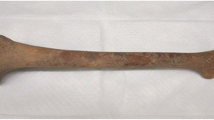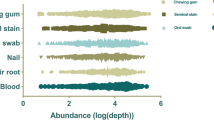Abstract
Skeletal remains encountered frequently in forensic applications are a challenging specimen, since their DNA is usually degraded due to harsh conditions, limiting the utilization of skeletal DNA. Forensic scientists have tried various methods to extract DNA from skeletal remains of low quantity and poor quality or improve detecting technology for more information from compromised DNA. Compared with traditional capillary electrophoresis (CE), massively parallel sequencing (MPS) is more sensitive to shorter fragments, able to detect allele sequences for variations from core motif or flanking regions, and able to detect more markers with a higher discrimination power. In this study, short tandem repeats (STR) and single nucleotide polymorphisms (SNP) from 35 human skeletons were genotyped by MPS platform, and CE method was also used to perform STR genotyping. The results indicated that the detection rates reached 100.00% in 16 of 35 samples with MPS method, while the same 100.00% was reached in only 9 samples with CE. The success rates of MPS were also higher than that of CE method in shared 21 loci (excluding Y-indel, DYS391, and SE33), especially in loci detected by MPS method only. Besides, all SNPs (124 and 90 SNPs in males and females) were detected in 18 samples of 35 samples by MPS method. Some intra-allelic sequence variants were observed in eight loci (D21S11, D8S1179, D5S2800, D3S1358, vWA, D2S1338, D1S1656, D12S391) using MPS technology. Interestingly, there is a sample showing genotyping disagreement in FGA locus. The clone sequencing verified that a “T” deletion discovered in flanking sequence of FGA led to wrong genotyping on Ampliseq Converge. Our results indicated that MPS could be adopted in qualified labs as a supplementary when the DNA of skeletal remains are hard to identify.





Similar content being viewed by others
Change history
18 June 2020
The name of an author was misspelled. The correct spelling is “Linlin Gao” instead of Linin Gao.
References
Thompson R, Zoppis S, McCord B (2012) An overview of DNA typing methods for human identification: past, present, and future. Methods Mol Biol 830:3–16
Clarke B (2008) Normal bone anatomy and physiology. Clin J Am Soc Nephrol 3:S131–S1S9
Loreille OM, Diegoli TM, Irwin JA et al (2007) High efficiency DNA extraction from bone by total demineralization. Forensic Sci Int Genet 1:191–195
Jakubowska J, Maciejewska A, Pawowski R (2012) Comparison of three methods of DNA extraction from human bones with different degrees of degradation. Int J Legal Med 126:173–178
Liu JY, Zhong C, Holt A, Lagace R, Harrold M, Dixon AB, Brevnov MG, Shewale JG, Hennessy LK (2012) AutoMate Express™ forensic DNA extraction system for the extraction of genomic DNA from biological samples. J Forensic Sci 57:1022–1030
Davis CP, King JL, Budowle B, Eisenberg AJ, Turnbough MA (2012) Extraction platform evaluations: a comparison of AutoMate Express™, EZ1® Advanced XL, and Maxwell® 16 Bench-top DNA extraction systems. Legal Med 14:36–39
McLamb JM (2017) Application of enhancement strategies for the improvement of discriminating forensic DNA profiles from human bones. Western Carolina University
Maciejewska A, Jakubowska J, Pawłowski R (2013) Whole genome amplification of degraded and nondegraded DNA for forensic purposes. Int J Legal Med 127:309–319
Kulstein G, Hadrys T, Wiegand P (2018) As solid as a rock—comparison of CE-and MPS-based analyses of the petrosal bone as a source of DNA for forensic identification of challenging cranial bones. Int J Legal Med 132:13–24
Fattorini P, Previderé C, Carboni I, Marrubini G, Sorçaburu-Cigliero S, Grignani P, Bertoglio B, Vatta P, Ricci U (2017) Performance of the ForenSeqTM DNA Signature Prep kit on highly degraded samples. Electrophoresis 38:1163–1174
Budowle B, Schmedes SE, Wendt FR (2017) Increasing the reach of forensic genetics with massively parallel sequencing. Forensic Sci Med Pathol 13:342–349
Apaga DLT, Dennis SE, Salvador JM, Calacal GC, de Ungria MCA (2017) Comparison of two massively parallel sequencing platforms using 83 single nucleotide polymorphisms for human identification. Sci Rep 7:398
Voelkerding KV, Dames SA, Durtschi JD (2009) Next-generation sequencing: from basic research to diagnostics. Clin Chem 55:641–658
Eduardoff M, Gross T, Santos C, de la Puente M, Ballard D, Strobl C, Børsting C, Morling N, Fusco L, Hussing C, Egyed B, Souto L, Uacyisrael J, Syndercombe Court D, Carracedo Á, Lareu MV, Schneider PM, Parson W, Phillips C, EUROFORGEN-NoE Consortium, Parson W, Phillips C (2016) Inter-laboratory evaluation of the EUROFORGEN Global ancestry-informative SNP panel by massively parallel sequencing using the Ion PGM™. Forensic Sci Int Genet 23:178–189
King JL, LaRue BL, Novroski NM et al (2014) High-quality and high-throughput massively parallel sequencing of the human mitochondrial genome using the Illumina MiSeq. Forensic Sci Int Genet 12:128–135
Wang Z, Zhou D, Cao Y, Hu Z, Zhang S, Bian Y, Hou Y, Li C (2016) Characterization of microRNA expression profiles in blood and saliva using the Ion Personal Genome Machine® System (Ion PGM™ System). Forensic Sci Int Genet 20:140–146
Butler JM (2006) Genetics and genomics of core short tandem repeat loci used in human identity testing. J Forensic Sci 51:253–265
Alaeddini R, Walsh SJ, Abbas A (2010) Molecular studies of time-and environment-dependent effects on bone DNA survival. Aust J Forensic Sci 42:211–220
Zhang B, Li Z, Li K, Chen P, Chen F (2019) Forensic parameters and mutation analysis of 23 short tandem repeat (PowerPlex(R) Fusion System) loci in Fujian Han Chinese population. Legal Med 37:33–36
Zhang J, Yang Z, Zhang X, Tao R, Zhang J, Chen C, Zhang S, Li C (2019) Genetic characterization of 21 autosomal STR loci of Goldeneye DNA ID 22NC Kit in Chinese She group. Legal Med 39:45–48
Yuan L, Ou Y, Liao Q, Gui J, Bai X, Ge J, Ye J, Zhang L (2014) Population genetics analysis of 38 STR loci in the She population from Fujian Province of China. Legal Med 16:314–318
Zhang Y, Wang Q (2017) A preliminary study of the effects of Miseq FGx sequencing system for degraded bone sample testing. Chin J Forensic Med 32:512–3,7
Gettings KB, Aponte RA, Vallone PM, Butler JM (2015) STR allele sequence variation: current knowledge and future issues. Forensic Sci Int Genet 18:118–130
Zhang QX, Yang M, Pan YJ, Zhao J, Qu BW, Cheng F, Yang YR, Jiao ZP, Liu L, Yan JW (2018) Development of a massively parallel sequencing assay for investigating sequence polymorphisms of 15 short tandem repeats in a Chinese Northern Han population. Electrophoresis 39:2725–2731
Børsting C, Mikkelsen M, Morling N (2012) Kinship analysis with diallelic SNPs–experiences with the SNPforID multiplex in an ISO17025 accreditated laboratory. Transfus Med Hemother 39:195–201
Walsh S, Liu F, Wollstein A, Kovatsi L, Ralf A, Kosiniak-Kamysz A, Branicki W, Kayser M (2013) The HIrisPlex system for simultaneous prediction of hair and eye colour from DNA. Forensic Sci Int Genet 7:98–115
Kosoy R, Nassir R, Tian C, White PA, Butler LM, Silva G, Kittles R, Alarcon-Riquelme ME, Gregersen PK, Belmont JW, de la Vega FM, Seldin MF (2009) Ancestry informative marker sets for determining continental origin and admixture proportions in common populations in America. Hum Mutat 30:69–78
Guo F, Zhou Y, Song H, Zhao J, Shen H, Zhao B, Liu F, Jiang X (2016) Next generation sequencing of SNPs using the HID-Ion AmpliSeq™ Identity Panel on the Ion Torrent PGM™ platform. Forensic Sci Int Genet 25:73–84
Zambelli F, Vancampenhout K, Daneels D, Brown D, Mertens J, van Dooren S, Caljon B, Gianaroli L, Sermon K, Voet T, Seneca S, Spits C (2017) Accurate and comprehensive analysis of single nucleotide variants and large deletions of the human mitochondrial genome in DNA and single cells. Eur J Hum Genet 25:1229–1236
Funding
This work was supported by the National Key R&D Program of China (2017YFC0803504) and the Program for the Top Young and Middle-aged Innovative Talents of Higher Learning Institutions of Shanxi.
Author information
Authors and Affiliations
Corresponding authors
Ethics declarations
Our research was approved by the Ethics Committee of Shanxi Medical University (Approval No. 2019sll024).
Conflicts of interest
The authors declare that they have no conflict of interest.
Additional information
Publisher’s note
Springer Nature remains neutral with regard to jurisdictional claims in published maps and institutional affiliations.
The original version of this article was revised: The name of an author was misspelled. The correct spelling is "Linlin Gao" instead of Linin Gao.
Electronic supplementary material
ESM 1
(DOCX 21 kb).
Rights and permissions
About this article
Cite this article
Liu, Z., Gao, L., Zhang, J. et al. DNA typing from skeletal remains: a comparison between capillary electrophoresis and massively parallel sequencing platforms. Int J Legal Med 134, 2029–2035 (2020). https://doi.org/10.1007/s00414-020-02327-8
Received:
Accepted:
Published:
Issue Date:
DOI: https://doi.org/10.1007/s00414-020-02327-8




